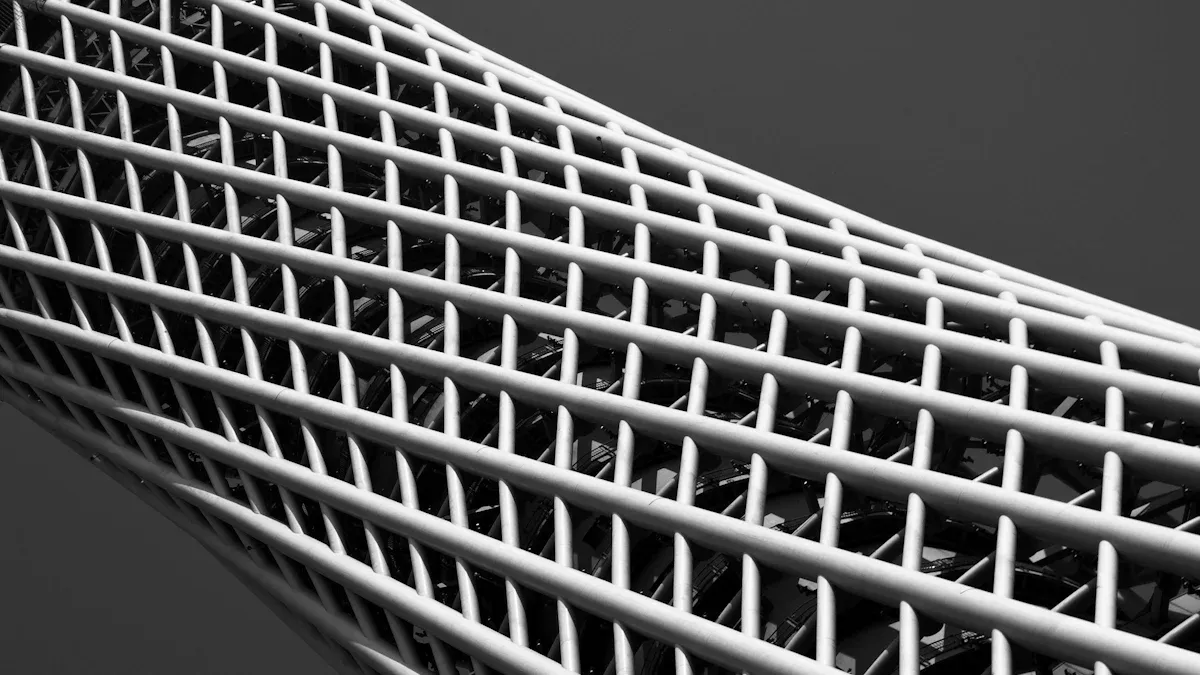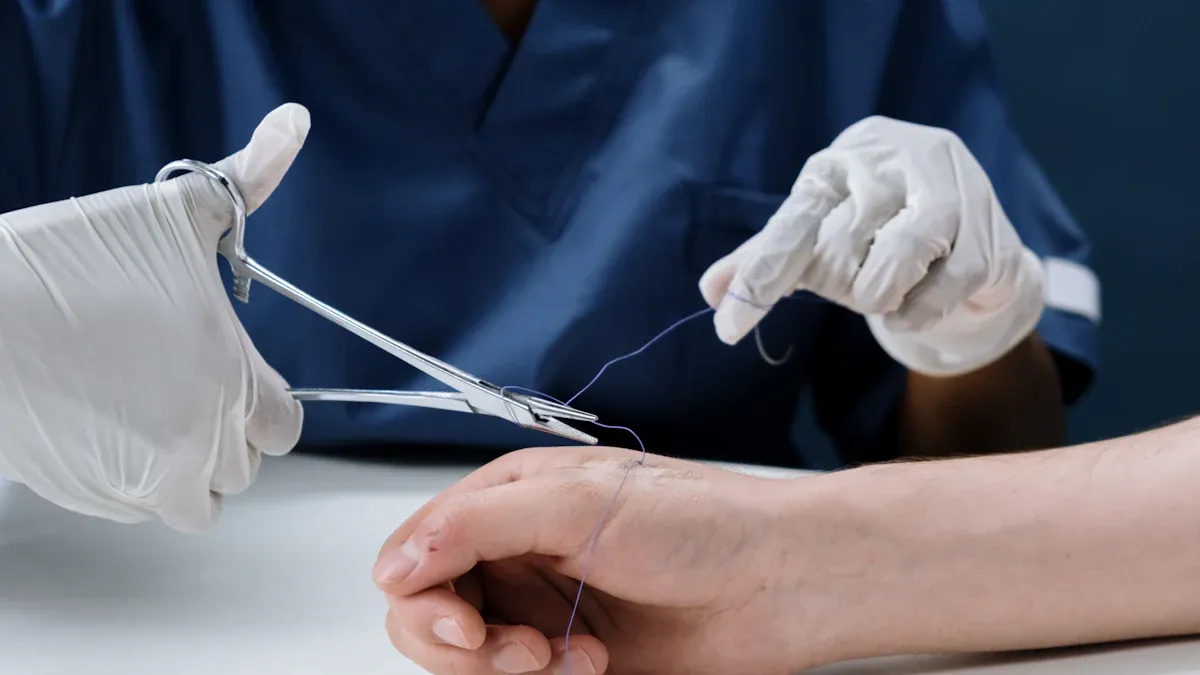How to Choose Nitinol Tubing for Stents

Choosing the right nitinol tubing for stents ensures safety, durability, and optimal performance. High-quality tubing minimizes tissue reactions, with histological scores consistently ranging from 0 to 1. Its superior fatigue life, up to three times greater than other materials, enhances long-term reliability. Stents crafted from precise tubing also achieve sustained clinical outcomes, such as a 30% reduction in intraocular pressure over six months. These benefits highlight the critical role of material selection in creating stents that meet both medical and patient needs.
Key Takeaways
Pick nitinol tubing for stents to ensure it is safe for the body, lowers swelling, and keeps patients safe.
Look for nitinol tubing that resists rust to make it last longer and work well in medical uses.
Pay attention to exact sizes and wall thickness to help stents work better and avoid problems when used.
Choose trusted suppliers with good certifications to get high-quality nitinol tubing that follows medical rules.
Use modern methods like laser cutting to keep nitinol stents flexible and able to return to their shape.
Material Quality

Biocompatibility for Stent Applications
Biocompatibility is a cornerstone of nitinol tubing for stents. This property ensures that the material interacts safely with the human body, minimizing adverse reactions. Nitinol's biocompatibility stems from its titanium dioxide passivation layer, which reduces inflammation and thrombosis risks. This makes it an ideal choice for stents used in sensitive areas like intracranial aneurysm treatments.
The material's non-ferromagnetic nature further enhances its safety profile. Unlike ferromagnetic materials, nitinol does not cause displacement or heating during MRI scans, ensuring patient safety during diagnostic procedures. The table below highlights the key aspects of biocompatibility in nitinol stents:
Aspect | Nitinol Stents |
|---|---|
Biocompatibility | Enhanced by titanium dioxide passivation layer, reducing inflammation and thrombosis risks |
MRI Safety | Non-ferromagnetic, ensuring no displacement or heating during scans |
Patient Safety | Critical consideration in intracranial aneurysm treatment |
By prioritizing biocompatibility, manufacturers can ensure that nitinol tubing for stents meets the highest safety standards, providing reliable solutions for patients.
Corrosion Resistance in Nitinol Tubing
Corrosion resistance is another critical factor in the performance of nitinol tubing for stents. Prolonged exposure to bodily fluids can lead to material degradation, compromising both safety and functionality. Nitinol's inherent corrosion resistance ensures long-term reliability, reducing the risk of adverse reactions in medical applications.
To further enhance this property, manufacturers often employ surface treatments like electropolishing and coating. These processes minimize the formation of corrosion pits, which can lead to fatigue cracks over time. Key benefits of nitinol's corrosion resistance include:
Excellent biocompatibility, reducing the risk of adverse reactions.
Long-term effectiveness, even during prolonged exposure to bodily fluids.
Enhanced durability through surface treatments like electropolishing and coating.
By combining biocompatibility and corrosion resistance, nitinol tubing for stents offers unmatched performance in demanding medical environments.
Fatigue Strength for Longevity
Fatigue resistance and durability are essential for stents, which must endure millions of cycles within the human body. Nitinol tubing excels in this area, offering superior fatigue strength compared to other materials. This ensures that stents maintain their structural integrity over time, even under constant mechanical stress.
Manufacturing techniques play a significant role in determining fatigue life. For example, TM-1 techniques produce nitinol tubing with smaller inclusion dimensions, resulting in a fatigue life that is 2-3 times greater than TM-2 techniques. The table below illustrates these differences:
Manufacturing Technique | Fatigue Life Characteristics | Endurance Limit Comparison |
|---|---|---|
TM-1 | Superior fatigue life due to smaller inclusion dimensions | 2-3 times greater than TM-2 |
TM-2 | Lower fatigue life due to larger inclusion dimensions | Lower than TM-1 |
Additional testing methods, such as cyclic fatigue tests and pulsatile fatigue tests, further validate nitinol's reliability. These tests simulate real-world conditions, ensuring that stents can withstand the rigors of daily use. Finite element analysis also predicts in vivo fatigue resistance, providing valuable insights into long-term performance.
By prioritizing fatigue resistance and durability, nitinol tubing for stents delivers exceptional reliability, making it a trusted choice for medical professionals worldwide.
Dimensional Precision
Accurate Dimensions for Stent Design
Precision in dimensions is vital for stent design. Nitinol tubing must meet exact specifications to ensure proper deployment and functionality within the human body. Accurate dimensions allow stents to maintain their structural integrity, deliver consistent performance, and minimize complications during implantation.
Key parameters define the dimensional accuracy required for effective stent design. These include wire diameter, ring mean diameter, number of turns, and bundle diameter. Each parameter plays a critical role in determining the stent's mechanical behavior and compatibility with the target anatomy. The table below highlights typical values for these parameters:
Parameter | Value (mm) |
|---|---|
Wire diameter | 0.180, 0.160, 0.220, 0.200 |
Ring mean diameter | 27.02, 33.16, 39.25, 48.09 |
Number of turns | 10, 8, 14, 9 |
Bundle diameter | 0.69, 0.53, 0.95, 0.72 |
These precise measurements ensure that stents crafted from nitinol tubing fit seamlessly within the vascular system, reducing risks and enhancing safety. The chart below illustrates trends in stent design parameters observed during experimental studies:
By adhering to these dimensional standards, manufacturers can produce stents that deliver reliable outcomes, improving patient safety and satisfaction.
Wall Thickness and Tolerance Standards
Wall thickness and tolerance standards are equally critical in nitinol tubing for stents. The tubing's wall thickness directly impacts its mechanical properties, including flexibility, strength, and fatigue resistance. A uniform wall thickness ensures consistent performance, while tight tolerance standards minimize variability and enhance reliability.
Manufacturers must prioritize precision during production to meet stringent tolerance requirements. Advanced techniques, such as laser cutting and electropolishing, help achieve the desired wall thickness and eliminate imperfections. These processes ensure that the tubing meets medical-grade standards, reducing the likelihood of complications during stent deployment.
The benefits of maintaining strict wall thickness and tolerance standards include:
Improved stent flexibility for easier navigation through complex vascular pathways.
Enhanced durability, ensuring long-term functionality under mechanical stress.
Reduced risk of adverse reactions, promoting patient safety.
By focusing on dimensional precision, including wall thickness and tolerance standards, manufacturers can create nitinol tubing for stents that meets the highest quality benchmarks. This commitment to precision ultimately translates to better clinical outcomes and increased patient trust.
Mechanical Properties
Flexibility and Elasticity in Nitinol Tubing
Flexibility and elasticity are essential for stents to adapt to the dynamic environment of blood vessels. Nitinol tubing for stents offers unmatched performance in these areas due to its unique material properties. Its ability to bend and return to its original shape ensures that stents can navigate complex vascular pathways without compromising structural integrity.
Quantitative comparisons highlight the advantages of nitinol's flexibility and elasticity. For instance, sensitivity to initial braiding angle and nitinol diameter varies with bending angles, as shown below:
Bending Angle | Sensitivity of Initial Braiding Angle (%) | Sensitivity of Nitinol Diameter (%) |
|---|---|---|
30° | 36% | 25% |
60° | 27% | 33% |
These properties make nitinol tubing ideal for stents, as they reduce the risk of vessel damage during deployment. Manufacturers often use advanced cutting tools, such as laser systems, to shape nitinol wire cutting with precision. This ensures that the tubing retains its flexibility while meeting strict medical standards. By prioritizing these qualities, nitinol stents deliver both safety and reliability in critical applications.
Shape Memory Behavior for Stent Performance
Shape memory and superelasticity are defining characteristics of nitinol tubing, making it a superior choice for stent applications. Shape memory behavior allows stents to compress for insertion and expand at the target site, ensuring optimal blood flow. This adaptability enhances safety by minimizing complications during deployment.
Self-expanding stents made from nitinol tubing adjust to the dynamic environment of blood vessels, reducing the risk of restenosis. Additionally, drug-eluting stents combine nitinol's mechanical advantages with medication delivery, preventing arterial blockages and improving patient outcomes. These innovations demonstrate how shape memory and superelasticity elevate stent performance to new heights.
To achieve these benefits, manufacturers rely on precise nitinol wire cutting techniques. Advanced cutting tools ensure that the tubing maintains its shape memory properties while meeting stringent dimensional requirements. This meticulous approach guarantees that stents perform reliably in even the most challenging medical scenarios.
Surface Finish

Smoothness for Reduced Complications
A smooth surface finish is essential for nitinol tubing used in stents. It minimizes complications during deployment and reduces the risk of adverse reactions. Stents with polished surfaces glide effortlessly through blood vessels, lowering the chances of tissue damage. Smooth finishes also prevent the accumulation of debris, which can lead to blockages or infections.
Manufacturers achieve this level of smoothness through advanced cutting tools and techniques like electropolishing. These processes remove imperfections and create a uniform surface that enhances the tubing's performance. For neurovascular stent nitinol tubing, smooth finishes are particularly critical. They ensure safe navigation through delicate brain vessels, reducing the likelihood of complications.
By prioritizing smoothness, manufacturers improve both the safety and reliability of stents. This focus on surface quality ensures that stents perform optimally in challenging medical environments, delivering better outcomes for patients.
Uniformity in Neurovascular Stent Nitinol Tubing
Uniformity in the surface finish of neurovascular stent nitinol tubing plays a pivotal role in its overall performance. Consistent finishes enhance fatigue resistance, ensuring stents withstand the mechanical stress of pulsating blood flow. Electropolished tubing demonstrates superior durability, withstanding up to 1000 mV without failure, compared to oxidized tubing's -117 mV. This remarkable difference highlights the importance of uniformity in surface treatment.
Advanced polishing techniques further improve biocompatibility, reducing the risk of inflammation or thrombosis. Real-time monitoring systems during production detect and correct variations in wall thickness, ensuring consistent quality. These measures are crucial for neurovascular stents, where precision and reliability directly impact patient safety.
Uniform finishes also optimize the tubing's interaction with cutting tools during nitinol wire cutting. This precision ensures stents retain their shape memory properties while meeting strict dimensional requirements. By maintaining uniformity, manufacturers create stents that deliver unmatched performance in neurovascular applications.
Supplier Reliability
Certifications and Quality Assurance
Certifications and quality assurance processes are critical when selecting a supplier for nitinol tubing used in stents. These measures ensure the tubing meets stringent medical standards, guaranteeing safety and performance. Suppliers with robust certification frameworks demonstrate their commitment to delivering high-quality and reliable products.
Key certification metrics and quality assurance standards include:
The ISO 25539 standard, which outlines pre-clinical evidence requirements for mechanical performance in stent certification.
FDA-endorsed computer modeling techniques, such as finite element analysis, to evaluate fatigue and durability.
The ASME VV-40 standard, which provides a framework for verifying and validating computational models.
Suppliers adhering to these standards ensure their nitinol tubing undergoes rigorous testing, minimizing risks during stent deployment. Advanced manufacturing techniques, including nitinol wire cutting and precision polishing, further enhance product quality. By prioritizing certified suppliers, manufacturers can confidently produce stents that meet the highest safety benchmarks.
Reputation and Industry Expertise
A supplier's reputation and industry expertise play a pivotal role in ensuring the reliability of nitinol tubing. Established suppliers with a proven track record often deliver superior products, backed by years of experience and innovation. Their expertise in advanced manufacturing processes, such as using cutting tools for precise nitinol wire cutting, ensures consistent quality.
Reputable suppliers also invest in research and development, staying ahead of industry trends. This commitment enables them to produce specialized products, such as neurovascular stent nitinol tubing, designed for delicate applications. Their focus on innovation and precision enhances safety and performance, reducing complications during stent deployment.
Partnering with experienced suppliers provides manufacturers with access to technical support and insights into emerging technologies. This collaboration ensures stents meet evolving medical standards, delivering better outcomes for patients. By choosing suppliers with a strong reputation, manufacturers can confidently produce stents that excel in both safety and reliability.
Selecting the right nitinol tubing for stents ensures safety, reliability, and optimal performance. Focus on biocompatibility, corrosion resistance, and fatigue strength to meet medical standards. Precise dimensions and mechanical properties enhance stent functionality, while a smooth surface finish reduces complications. Collaborating with reputable suppliers guarantees access to certified materials and advanced manufacturing techniques like nitinol wire cutting. These steps empower manufacturers to produce stents that deliver exceptional outcomes and improve patient care.
FAQ
What makes Nitinol tubing ideal for stents?
Nitinol tubing offers unmatched biocompatibility, corrosion resistance, and fatigue strength. Its shape memory and superelasticity ensure stents adapt to blood vessels, reducing complications. Manufacturers rely on advanced techniques to maintain precision, making Nitinol the preferred choice for medical applications.
How can manufacturers ensure dimensional accuracy in Nitinol tubing?
Manufacturers achieve dimensional precision through laser cutting and electropolishing. These techniques ensure consistent wall thickness and tight tolerances, enhancing stent performance. Accurate dimensions reduce risks during deployment and improve patient outcomes.
Why is surface finish critical for Nitinol stents?
A smooth surface finish minimizes tissue damage and prevents debris accumulation. Electropolishing removes imperfections, ensuring stents glide effortlessly through blood vessels. This enhances safety and reliability, especially in neurovascular applications.
What certifications should suppliers provide for Nitinol tubing?
Suppliers should meet ISO 25539 and ASME VV-40 standards. These certifications ensure the tubing undergoes rigorous testing for fatigue, durability, and mechanical performance. Partnering with certified suppliers guarantees high-quality materials for stent production.
How does supplier expertise impact Nitinol tubing quality?
Experienced suppliers use advanced manufacturing techniques and invest in R&D. Their expertise ensures consistent quality and innovation, reducing complications during stent deployment. Collaborating with reputable suppliers enhances safety and reliability.
See Also
Choosing the Right Nitinol Tubing Supplier for You
A Comprehensive Guide to Selecting Nitinol Tubing
The Manufacturing Process of Nitinol Tubing for Medicine
Tensile Strength Comparison: Nitinol Tubing vs. Stainless Steel
The Importance of Nitinol Tubing in Minimally Invasive Surgery

